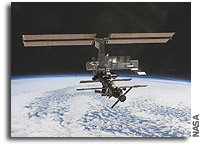NASA Space Station Status Report 20 Aug 2004

The International Space Station (ISS) crew is focusing
this week on the new equipment and supplies that arrived last
Saturday aboard a Russian cargo spacecraft.
Expedition 9 Commander Gennady Padalka and NASA ISS Science
Officer Mike Fincke unloaded most of the two-and-a-half tons
of cargo this week. They then shifted their attention to
cataloguing and stowing the material using the Station’s
computerized, bar code-based Inventory Management System. The
ISS Progress (15) docked to the aft port of the Zvezda
Service Module at 1:01 a.m. EDT Saturday, bringing fuel,
water, oxygen, air, spare parts and other supplies.
Other activities for the crew during the week included a
reboost of the Station, moving the Station’s robotic arm into
position for an upcoming spacewalk and continuing science
experiments.
On Tuesday, Padalka and Fincke installed a new system in the
Progress craft that allows the crew to command Progress
thruster firings from the Zvezda module. The thruster control
system was tested and then used in a reboost yesterday that
raised the Station’s altitude by about three statute miles.
The ISS is now in an orbit with a high point of 228.7 miles
and a low point of 215.5 miles. Another Station reboost is
scheduled next week to prepare for the October arrival of a
Soyuz spacecraft that will bring a new crew to the outpost.
Yesterday, the crew spent about an hour moving the Station’s
Canadarm2 into position for its cameras to view the upcoming
spacewalk, scheduled for Sept. 3. During the spacewalk, the
crew will use Russian Orlan spacesuits and the Russian
airlock to install additional navigation equipment in
preparation for next year’s maiden flight of the European
Automated Transfer Vehicle supply spacecraft.
A press briefing on the spacewalk, the fourth and final
outside excursion planned during Expedition 9’s stay on the
Station, will be held at 2 p.m. EDT Aug. 27 at NASA’s Johnson
Space Center, Houston. The briefing will be carried live on
NASA Television.
Fincke will spend some time next week continuing to
troubleshoot U.S. spacesuit cooling system problems. New U.S.
spacesuit cooling system pumps were among the spare parts
delivered aboard the new Progress last weekend.
Science activities this week included biomedical crew
observations and tests, among them a look at bioelectrical
activity of the heart and audiograms and work on a Russian
plant growth experiment.
Fincke also conducted another imaging session of the Binary
Colloidal Alloy Test-3 (BCAT-3) experiment. He took a total
of 157 photos documenting the formation of particle
suspensions in homogenized liquids. Possible future
applications of the colloidal alloy experiments are photonic
crystals for telecommunications and computer applications and
extremely low threshold lasers, as well as improved use of
supercritical fluids for food extractions, pharmaceuticals,
dry cleaning, and rocket propellants.
Both Fincke and Padalka conducted a session with the
Educational Payload Operations by demonstrating a musical
instrument called a chicken shake. Crewmembers showed how
microgravity affects the egg-shaped percussion instrument
that is very similar to Cuban Maracas without the handles. In
Caribbean or South American orchestras, chicken shakes are
used in the percussion section to add to its variety of
rhythms, textures and tone colors. The sessions were
videotaped and downlinked for later use by the Maryland
Science Center in educator workshops designed to educate
hearing impaired students about sound and the physics of
sound.
For information about NASA and agency missions on the
Internet, visit:
Information about crew activities on the Space Station,
future launch dates and Station sighting opportunities from
Earth, is available on the Internet at:
Details about Station science operations are available on an
Internet site administered by the Payload Operations Center
at NASA’s Marshall Space Flight Center in Huntsville, Ala.,
at:








